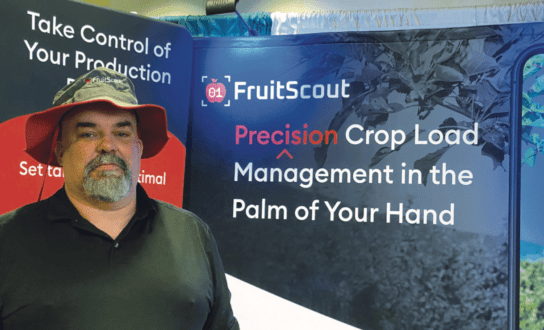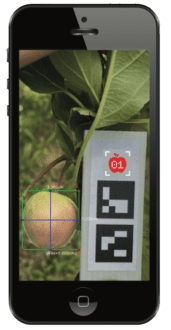

Apr 7, 2022FruitScout pinpoints cropping targets
Precision crop load management is routinely identified as the most important management strategy that determines the annual profitability of apple orchards.
It’s also the most challenging tool to implement successfully.
Growers recognize the economic impact of achieving proper crop load each year is large and justifies a more focused approach. Matt King, CEO and co-founder of FruitScout, believes the rigors of the management process can be eased with a simple, relatively inexpensive solution.


With a smartphone, growers can access an app that helps count buds, blooms and fruitlets to help growers streamline their crop load management strategies.
FruitScout is positioning itself as providing an easy-to-use smartphone app with computer vision and business intelligence tools. It enables growers to set targets for optimal crop load; monitor and measure from bud to bin to stay on track; and maximize orchard profit year to year.
“We came out of the greenhouse world,” King, a former Boeing engineer, told Fruit Growers News. “Our previous company did greenhouse technology bots, functionally similar to a drone, taking pictures, measuring everything.
“Boeing had this idea long ago when I was there, of measuring every widget with a camera at each step in the process in the instrumenting systems,” King said. “That’s the approach we brought into the greenhouse world. We’re mostly here in western Washington where they grow a lot of apples. We worked with Dan Plath at Washington Fruit that basically brought us kicking and screaming into the orchards. We started with drones. Then, we went to mounted cameras on tractors. We had a customer in Australia very early in the COVID days. We couldn’t fly down there, didn’t want to ship hardware, so I said, ‘OK, I’ll just build a demo on the phone.’ Just a demo to show them what we have. We were testing it in Washington Fruit’s orchard, and the head grower there walked by and came up to me and said, ‘I want that.’ A lightbulb went off in my head and I said, ‘why did I not think of this before.’”
“The phone is already in the grower’s pocket. They already are in the orchard,” King said. “So, it gets away from needing expensive hardware. From an entrepreneurial point of view, another way to express that is, Apple and Samsung are great at making hardware. Why do we want to reinvent the wheel? Let’s use their hardware. Let’s use a human being that’s already there. Because what that does is it opens up the market to us.
“If you look at our competitors who brought a hardware knife to a software gunfight, well, they have to have different hardware to do things in parallel. You think of an outfit like Washington Fruit, where they’re doing the hard thinning, there’s only a couple of weeks window in there. So, if you have a hardware solution, you have to have multiple copies of that hardware. You can’t just take one drone, or one Gator, one tractor and move it around to all of the orchards.


“So, there is this very large expense in hardware that you have to have,” King said. “Even if you’re getting it from a service, there’s a lot of that hardware to do all of this data collection in parallel. Whereas, with us, the grower’s there. He has a phone. The workers, even the migrant workers, they have phones. They have great phones. They have better phones than I do, generally. So that really completely opened up the gates for us.”
“We then launched small-scale pilots last year in January with seven different growers, Washington Fruit being the big one here in Washington, and then a lot of smaller ones in Pennsylvania and New York. We’ve started to talk to some folks in Michigan. We ran a full year pilot of it.”
FruitScout adapted Cornell University’s crop load management model.
“We didn’t invent precision crop load management. We developed a process,” King said. “Going back to my Boeing days, what we did was find a way to instrument that process.


“You start out by taking a picture of the trunk to get the trunk size,” King said. “This code is a geo-reference code. It gives a range of the data from the camera. It’s not a QR code. It’s the same code everywhere. You just put it on the end of a selfie stick and move it along with you. I’m measuring the trunk size to give us the optimal crop load. On the data acquisition side, you’re just walking down the row taking pictures. Then when it gets time for bud counting, you take a picture of the tree with all of the little buds on it, before and after pruning, to measure the process of pruning.
“It’s the same thing with blooming,” King said. “You’re taking a before, you’re taking an after to tell you how your hand thinning or chemical thinning worked.
“When we get to the fruitlet phase, we use the fruitlet growth model. Again, we did not invent it. Both Terrence Robinson at Cornell and Duane Greene at the University of Massachusetts were the pioneers behind this method. But with their method, you have to come with calipers and you have to measure the exact same fruit. If you try and do it on a scale you’re going to spend time getting numbers on little fruitlets and it’s just cumbersome to do.
“We took the process down to something very simple. You can take a picture of a fruitlet, come back four days later and take another picture. It doesn’t have to be the same fruitlet.
Obviously, you have to repeat it. You need to go to about 500 fruitlets on a block. But you don’t have to go through all of the work to make sure you’re getting to the exact same fruitlet every time. And keeping them in order, and all of that headache. You walk down a row, you take a picture, you’re done.
“That size measurement we then use to calculate the growth rate,” he said. “It will tell you the set rate after a chemical spray. So, we’re measuring size and we’re providing the set rate.
Part 2: Grower, researcher look at the viability of FruitScout››
Later in the season, obviously what you care about is the size of your fruit and how it’s growing. We provide that, as well. All you’re doing is taking a picture.
“The whole idea here is giving them information so they can get down to the individual tree level to get the maximum final result,” King said. “This is not a volume game. They’re not trying to grow more apples. They’re trying to grow a precise-sized apple. The size of the apple is determined by the number of fruit on the tree. That’s the optimal crop load.
“This all comes from that picture of the trunk,” King said. Now, you’ve got a target for the season. And then we give them stage targets which then they can adjust. What’s the target of the buds? What’s the target of the bloom? What’s the fruitlet phase?
“They can look at this at the individual tree level to make decisions about pruning. They can roll it up and look at the row, block or orchard level. For managers who want to know what’s going on, it’s quite simple to use.”
(Next month: A closer look at FruitScout, including the experiences of a grower and a researcher who analyzed the application’s early performance.)
– Gary Pullano, editor














